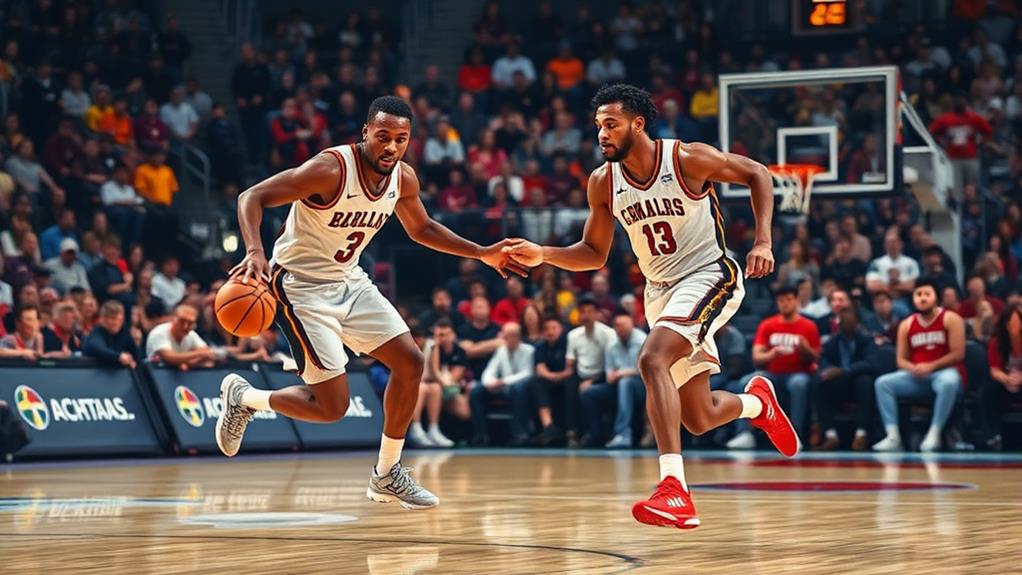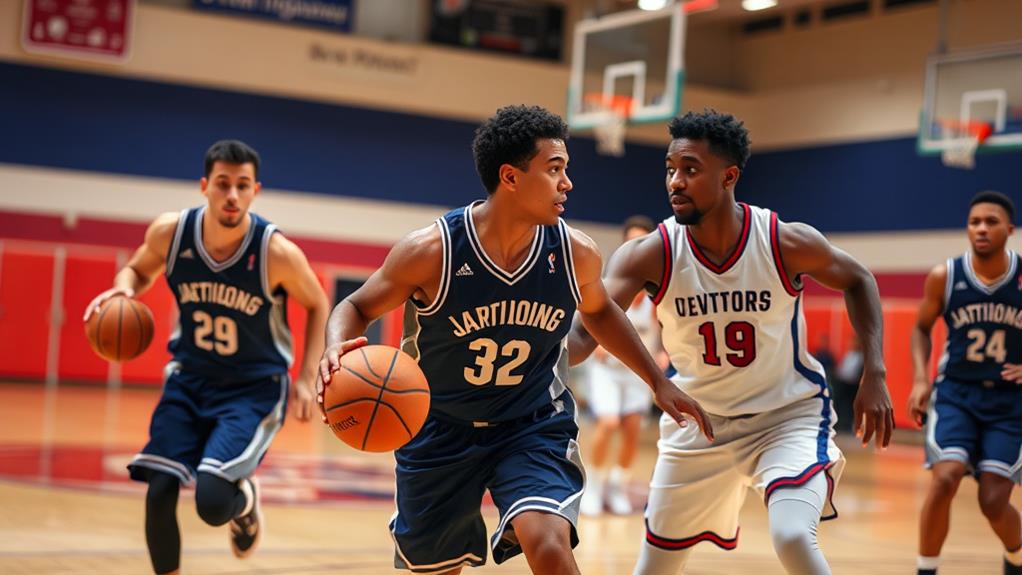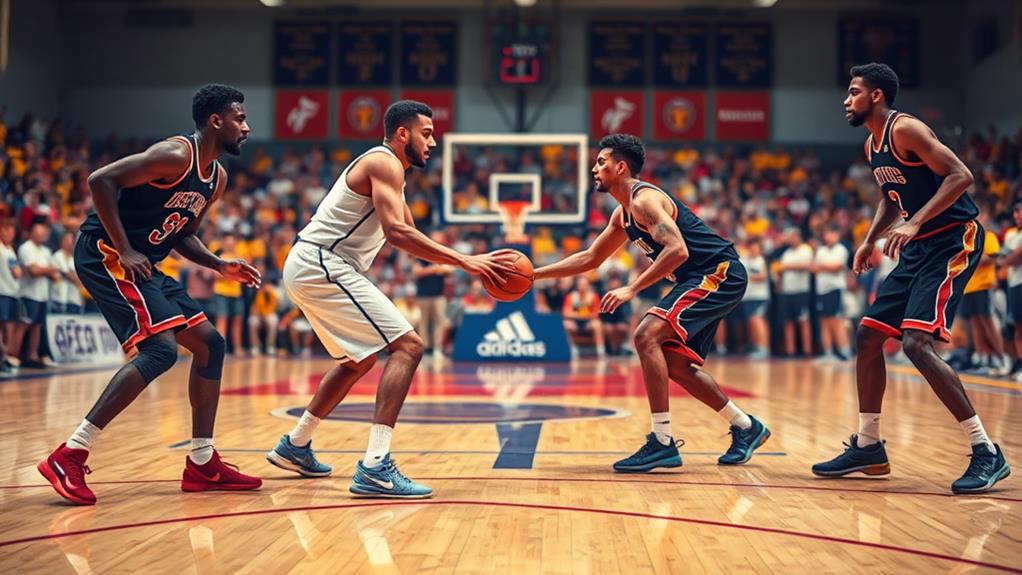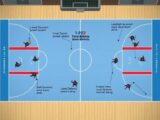
Understanding DHO (Dribble Hand Off) in Basketball
September 18, 2024Understanding DHO (Dribble Hand Off) is key to boosting your basketball performance. This offensive tactic involves a player dribbling towards a teammate and handing off the ball, creating a quick screen for the receiver. It's most effective when players keep minimal space between them, allowing for a seamless transfer. Use DHO to exploit mismatches when defenders switch or overcommit. Solid execution relies on timing and communication, making practice essential. By mastering the DHO, you'll create more scoring opportunities and keep defenders on their toes. There's plenty more to explore about this effective strategy that can elevate your game.
Definition of DHO in Basketball
A dribble handoff (DHO) in basketball is an offensive tactic where one player, dribbling toward a teammate, hands off the ball while continuing their movement. This seamless maneuver requires minimal space between you and the player receiving the ball, which sets it apart from traditional passes that need 12 to 15 feet of separation.
By executing a DHO, you create an immediate screen for the receiving player, allowing them to either shoot or drive toward the basket. This tactic is similar to strategies seen in other sports, such as soccer moves guide, showcasing how teamwork can enhance performance.
Typically, these handoffs are executed outside the paint. This positioning optimizes spacing and leads to downhill attacks against defenders.
As you engage in a DHO, keep an eye on the defense; effective execution can cause defenders to switch, which often results in advantageous mismatches. This opens up scoring opportunities for your team, allowing the player receiving the ball to capitalize on a defender who might be less equipped to handle them.
Mastering the DHO not only enhances your offensive play but also makes you a more versatile player on the court. With practice, you'll find that integrating the dribble handoff into your game can greatly elevate your team's scoring potential.
When to Use a DHO
Using a DHO effectively hinges on recognizing key moments during the game. You'll want to initiate this play when the player with the ball is positioned outside the paint, maximizing spacing and creating motion within your offense. The best time to execute a DHO is when the distance between you and your teammate receiving the handoff is minimal. This guarantees a smooth transfer of the basketball, allowing for immediate offensive action.
Data-driven strategies, such as optimizing shot selection accuracy, can enhance the effectiveness of your DHO execution and lead to better scoring opportunities impact of analytics on player performance.
Look for opportunities to generate downhill attacks, especially when defenders are caught switching. A well-timed DHO can put pressure on help defenders, creating open jump shots or driving lanes. If you notice the defense overcommitting or out of position, it's the perfect moment to implement a DHO. This tactic disrupts their alignment and enhances your offensive flow.
In fast-paced sequences, a DHO can be particularly effective, as it keeps the defense guessing and allows your team to exploit mismatches. Use this strategy wisely, and you'll find that it not only enhances your team's scoring opportunities but also keeps the defense on their toes.
Effective DHO Examples

Effective DHO examples can showcase how this tactic elevates offensive play and creates scoring opportunities. When you execute dribble handoffs, you can open up the floor for your teammates, especially if you have a skilled shooter ready to take advantage of the opportunity. This strategy can be particularly effective in counteracting modern defensive approaches that emphasize perimeter defense, as successful execution can exploit mismatches and create open shots for high-efficiency shooters historical shifts in defensive approaches.
Imagine a scenario where you pass the ball to a teammate who's waiting to receive the handoff; if the defense switches, it creates a favorable mismatch you can exploit.
One effective example is when you set a screen for a player receiving the handoff. As the ball-handler, you can either drive to the basket or pull up for an open jump shot, depending on how the defense reacts. This unpredictability forces defenders to make quick decisions, often leading to breakdowns in coverage.
Another scenario could involve using DHO in movement, catching the defense off-guard. By quickly passing the ball during a handoff, you can create space and rhythm for your shooter.
Watching video clips of successful DHO plays can give you insight into timing, positioning, and execution, making it easier to implement this strategy in your own gameplay.
Teaching DHO Techniques
Executing a successful dribble handoff (DHO) requires a solid foundation in technique, which is fundamental for enhancing your team's offensive efficiency. Centers, with their ability to stretch the floor and facilitate ball movement, can play a significant role in creating effective DHO opportunities.
To start, focus on timing and coordination with your teammate; the handoff should occur smoothly, without delays or mistakes. When you approach the player, minimize the space between you to reduce the chance of a defender intercepting the ball. Keeping the ball in motion throughout the exchange is essential.
Effective communication plays an important role in this process. Use non-verbal cues, like maintaining eye contact, to signal your intentions and guarantee your teammate is ready to receive the pass to player. This anticipation helps both of you execute the DHO seamlessly.
Centers' ability to draw defensive attention can open up lanes for successful handoffs, enhancing overall team dynamics and scoring potential offensive versatility and mismatches.
Practice DHO techniques regularly through dedicated drills to improve your control and precision. Pay attention to your body positioning and avoid common errors, such as moving screens that can disrupt the play or creating too much space, which can lead to turnovers or defensive interceptions.
Defensive Strategies Against DHO

When facing a dribble handoff, you can use switching strategies to create mismatches that disrupt the offense.
This approach aligns with the importance of effective marking and pressing to regain possession quickly.
Alternatively, going under the handoff can be effective, especially against players who aren't strong shooters.
It's all about knowing when to adjust your tactics to limit the offense's options.
Switching Defensive Strategies
Switching defensive strategies during dribble handoffs (DHOs) can notably disrupt the offensive flow. When you switch, the defender guarding the passer and the receiver exchange assignments, creating mismatches that can throw off the offense's rhythm. This tactic can force offensive players to adjust quickly, which might lead to confusion or mistakes.
However, switching isn't without risks. If a slower defender ends up matched against a quicker offensive player, it could open scoring opportunities for the offense. So, effective communication and anticipation become critical. You need to recognize when to switch and confirm that everyone on the team is on the same page to avoid defensive breakdowns.
Many teams combine switching with other tactics, like hedging, to further challenge offensive players. This layered approach can make it difficult for the offense to capitalize on the DHO, as they must constantly adapt to changing defensive alignments.
Ultimately, mastering switching strategies can greatly enhance your team's defensive prowess against dribble handoffs, keeping the offense on its toes and increasing your chances of securing possession.
Going Under Techniques
After considering the effectiveness of switching defensive strategies, it's important to explore another tactic: going under during dribble handoffs (DHOs). This technique involves you, as the defender, taking a route beneath the player executing the handoff. By doing this, you limit the offensive player's ability to drive toward the basket, especially when they aren't a significant shooting threat.
Going under can effectively prevent dribble penetration, forcing the offensive player to either take a longer, less favorable shot or seek out alternative options. However, this strategy carries risks. If the offensive player has time and space, they might capitalize on the situation, leading to open shots for teammates.
To execute the go-under technique successfully, effective communication and anticipation are essential. You need to be aware of the offensive player's shooting capabilities and tendencies.
Offensive Counters to DHO Defense
When facing a tight defense against the dribble handoff, you can employ several effective counters.
Understanding the importance of field dimensions and equipment requirements can help determine the best positioning and spacing during gameplay.
A backdoor cut can exploit defenders who overcommit, while a fake handoff can create space for you or your teammates.
Additionally, re-screening after the initial handoff can give you the opportunity to attack with renewed momentum.
Backdoor Cut Strategies
A backdoor cut serves as a powerful tactic against defenses that aggressively pressure the dribble handoff (DHO). When defenders overcommit, you can exploit the space they leave behind, creating scoring opportunities.
To effectively implement this strategy, keep these key points in mind:
- Read the Defender: Time your cut when the defender turns their head.
- Communicate: Use eye contact or subtle gestures with the ball handler to signal your intention.
- Cut Hard: Make an explosive move towards the basket to catch the defense off guard.
- Utilize Screens: Incorporate a ball screen to further confuse defenders and open up space for your backdoor cut.
- Finish Strong: Be ready for a layup or an open shot if you get free.
Fake Handoff Techniques
Deception is a crucial element in basketball, especially when facing defenses that aggressively defend the dribble handoff (DHO). A well-executed fake handoff can exploit defenders who overcommit, opening up driving lanes or shot opportunities for you.
As the ball dribbles toward your teammate, make sure your body language convincingly simulates the handoff without actually delivering the ball. This precision in timing is key to drawing the defender in.
When you use the fake handoff, it can trigger defensive reactions that create chaos. This confusion allows teammates to make quick cuts or set screens, taking advantage of the defense's momentary lapse.
It's essential for the player receiving the fake handoff to maintain good spacing and be ready to either shoot or drive based on how the defense reacts.
Practicing the fake handoff in drills not only sharpens this skill but also enhances team chemistry. The more effectively you execute this technique, the more versatile the DHO becomes as an offensive threat, making it harder for defenders to predict your next move.
Embrace the fake handoff, and watch how it transforms your offensive game.
Re-Screen Opportunities
After mastering the fake handoff, you'll discover the power of re-screen opportunities. This tactic allows the player who initially set the screen for the DHO to re-establish a screen after the handoff, opening up new scoring chances. It's a strategic response to common defensive maneuvers like switching or going under, forcing defenders to quickly adapt.
To effectively utilize re-screens, keep these key points in mind:
- Timing is everything: Coordinate your movements with teammates to set the screen at the perfect moment.
- Communicate clearly: Verify everyone understands the defensive coverage to execute the re-screen successfully.
- Read and react: Assess the defense's response to the DHO and adjust your positioning accordingly.
- Create mismatches: Force defenders into awkward situations, especially if they fail to switch effectively.
- Practice in drills: Regularly work on re-screens to enhance team chemistry and develop instincts.
When a player receives the ball, the re-screen can set them up for a clean pass or an open shot, maximizing scoring potential. Embrace re-screens to become a more dynamic offensive player!
Conclusion
Incorporating the dribble handoff into your game can elevate your offensive strategy and keep defenders guessing. Imagine the thrill of executing a perfect DHO, creating space for a teammate to drive or shoot. By mastering this technique and understanding when to use it, you can become a more versatile player. So, are you ready to turn your next game into a showcase of skill and teamwork? Embrace the DHO, and watch your impact on the court grow!


